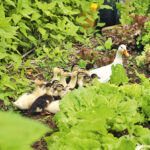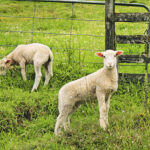Goodbye mortgage, hello remote living: Buying an untamed 6ha block was this couple’s ticket to self-sufficiency
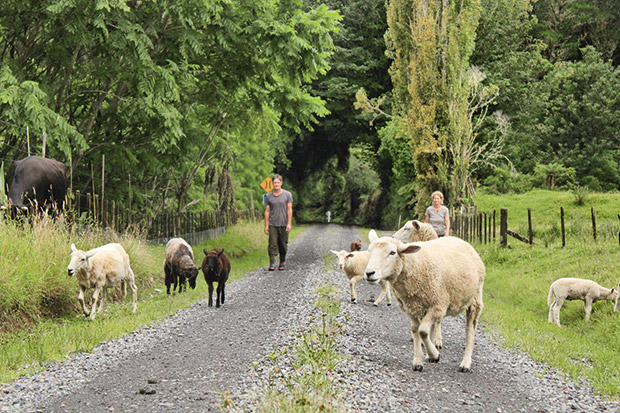
The family is self-sufficient in meat, producing and butchering lambs and pigs. They also want to raise calves from their house cow for beef.
A family committed to a self-sufficient way of life have quickly turned an untamed block into a productive homestead.
Words: Nadene Hall Photos: Summer Stewart
Who: Rebecca, David, Genny, and Summer Stewart
What: 6ha (14.8 acres)
Where: National Park, 1 hour south-west of Taumarunui
Web: ‘Fodder Farm’ (their farm’s page) and ‘Homesteading New Zealand’ (Rebecca’s group)
To get to the Stewart family’s homestead, you head south from the heart of the King Country. It’s already a place where the locals use words like ‘wild’ and ‘untamed’ to describe the landscape.
Then you turn and take a 40-minute drive into the middle of nowhere, exactly where Rebecca and David Stewart want to be. They subdivided and sold their block in the tiny Manawatu village of Apiti in early 2020 to make this move. Choosing to buy 6ha of land, most of it in pines in such a remote place, meant no mortgage and treasured financial independence.
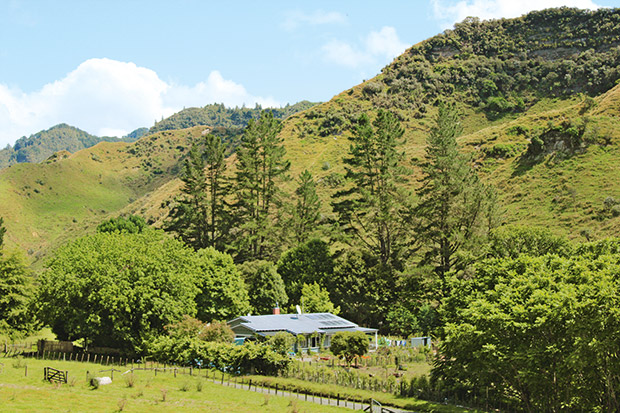
“Purchasing it left us with a little bit of capital to achieve some stuff,” says Rebecca. “We definitely didn’t want to have any debt. It’s great knowing you don’t owe anyone anything.
“Also, we live quite simply. We don’t pay out money for lots of stuff unless it’s something we seriously need for the house or land. With our eldest daughter Genny (who has Global Development Delay), holidays aren’t an option, but it doesn’t bother us at all because we get the life we want.”
When people say they want to be self-sufficient, it’s often a long-term goal. For Rebecca and David, it’s their daily mission.
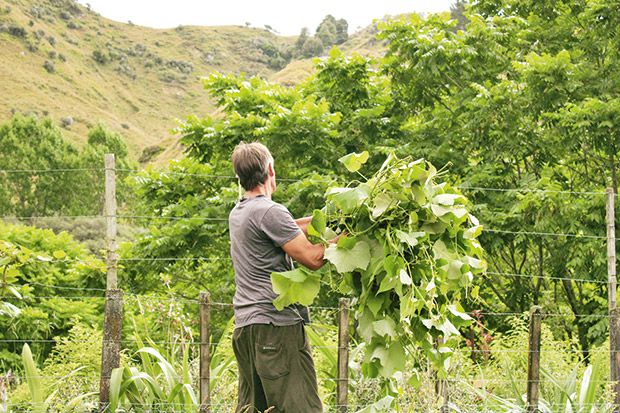
“We want to know where things come from, what’s gone into them, take responsibility for our health, our children’s health, our land’s health. We do bring in resources, and we can access the internet. But if someone flicked the switch tomorrow, say there was a big natural disaster, we’d be fine.”
Living this far from civilisation might seem daunting, but it’s “no big deal” for the couple who both grew up on working farms. “It doesn’t feel remote,” says Rebecca. “We’re only an hour from town, and we’ve lived a lot of our lives 40 minutes, an hour from town. Sometimes, it can be a pain, like when we had to get a quad bike and we ended up going to Waitara (four hours drive) to get it at a reasonable price.”
HOMESTEADING
The distance doesn’t stop her from running the increasingly popular Homesteading New Zealand group on Facebook. She also posts regular updates on their farm’s transformation to its own page (Fodder Farm).
“I can’t quite remember where I came across it (homesteading). It’s a really big term in America, not so much here. Back in the old days, the homestead was the heart of a property, its main food production unit except for maybe a few staples, and it would feed (the family) and maybe the community around them.”
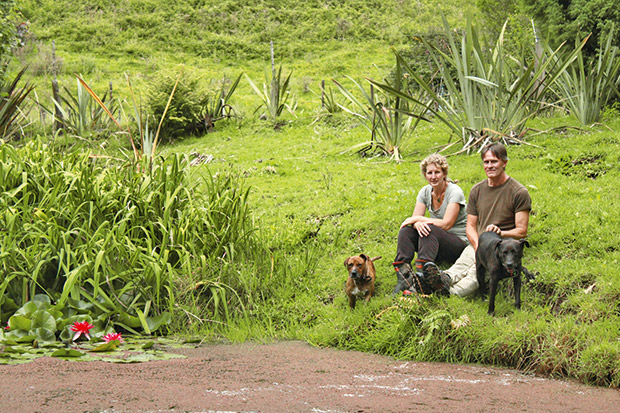
Rebecca says she likes the term because it so perfectly encompasses their kaupapa (philosophy).“We’re closing the loop, growing most of our own food. We’re big on food and natural health, we’re quite big advocates for low carb (for health reasons), and if you mainly eat meat and veggies, you can grow that on a lifestyle property.”
The Facebook group started as a place for Rebecca to save information on homesteading that she found interesting. She shared it with a few like-minded friends, and they started talking about their projects. “More people started asking to join, and now we have over 2800 members. You need to have pre-approval for posts, and that stops a lot of rubbish.”

A recent post by a member answering questions about processing meat rabbits is an example of the practical information members find useful. “We have a handful of people who are quite good at sharing their journey, which I appreciate, and there are so many interesting people out there. I want more people to live this way, and hopefully it helps people take the plunge. It’s not an easy lifestyle. A lot of people think they’re going to just sit on the deck with their wine.”
THE FARM’S FIRST STEPS
They moved to the new farm in May 2020 to find a large flock of feral ducks and chickens had taken over.
The garden was a mess – part of it completely smothered by a rogue grapevine – and there was no infrastructure except for a shed. They locked their sheep, cow, and pigs in the pine block while they got started. Unfortunately, the pigs didn’t get the memo.
“They were everywhere with no real containment, it was a little bit crazy trying to keep the pigs out of things, with electric fences everywhere.” But in just 10 months, the family has transformed the property. The first jobs were to fence off the vegetable garden, make a pig pen, and build a coop. “It’s mostly David,” says Rebecca.
“We don’t go out to ‘work’, so we do have time to spend on these things, and David… when he gets into a job, he just does it, so I’m very lucky, I couldn’t do this on my own.”
By August, the couple had created 140m² of food gardens, moved 20 fruit trees from what’s now a grazing paddock to the orchard, and added more for a total of 87 fruit and nut trees. Every now and then, Rebecca found a treasure in the overgrowth: a large nectarine tree, a flatto peach, and in spring, she discovered an old tree by the driveway was an olive when it burst into flower.
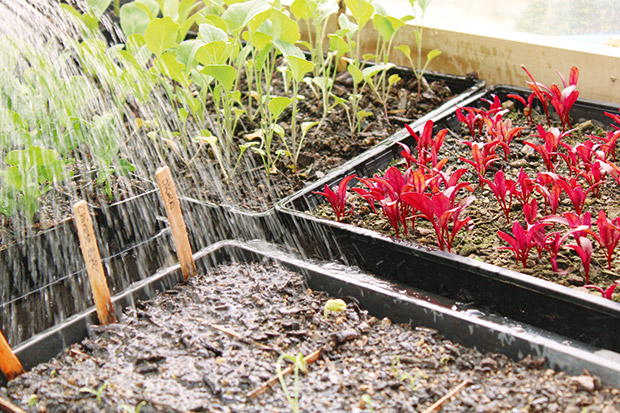
Their soil is volcanic loam thanks to eruptions by the locals (Mt Ruapehu and Mt Ngāuruhoe), but a soil test found it’s not as nutrient-filled as they thought. That’s partly due to the region’s high rainfall. A simple downpour can send torrents of water gushing through and around their new beds at alarming speeds.
To manage it, they’ve built swales and drains throughout the garden. Every vegetable bed is covered in thick layers – or blankets, as Rebecca calls them – of mulch, including barley straw, grass clippings, leaves, and any plant overgrowth that’s not fed out to their livestock. David has been reading and experimenting with Korean natural farming methods. The goal of KNF is to encourage indigenous micro-organisms (MOs) to build a thriving soil ecosystem.
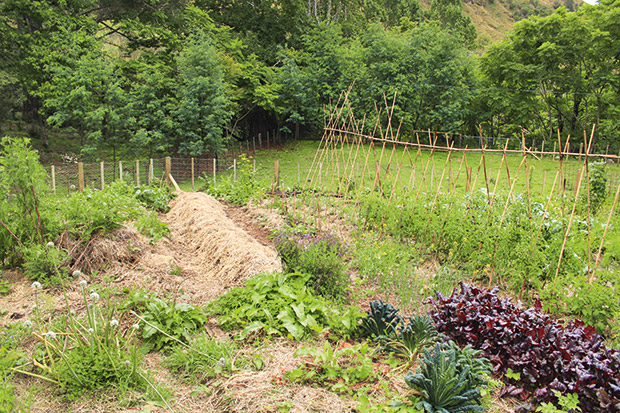
The couple are using Korean natural farming methods to create a more nutrient-rich soil. It’s difficult to find information as a lot of it has yet to be translated into English, but Rebecca says there’s an excellent overview on Wikipedia.
Fertile, healthy soil contains more MOs in one teaspoon than there are people on the planet. These underground ‘livestock’ feed on organic matter – the more there are, the faster they decompose it – which creates more plant-available nutrients.
“This process of nutrient cycling is what we’re trying to achieve,” says Rebecca. “Basically, it’s biological farming and gardening, with living amendments and a lot of fermentation of the ingredients.”
The brews are David’s babies, and include fermented plant juice, lactic acid bacteria, fish amino acids, and water-soluble calcium, all made using locally sourced ingredients where possible. “That way, you’re using indigenous MOs to bring life back to your soil.”
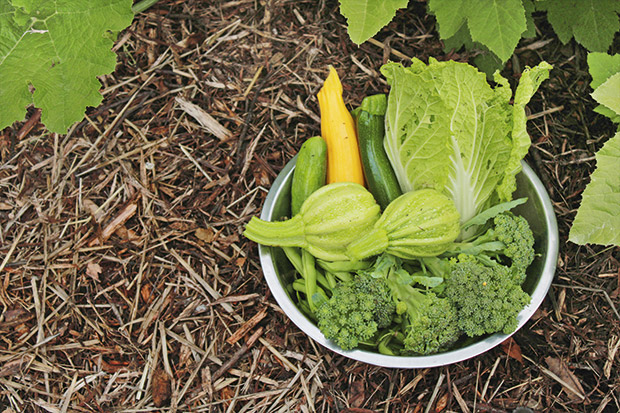
One of his most recent brews was a ferment of young comfrey tips and brown sugar. The brown sugar draws the plant juices out, which then feeds a growing population of MOs. “We paid really close attention to the plants he was spraying. We feel (the sprays) are really making a difference, thicker, healthier leaves, and good growth.”
The philosophy of Korean natural farming is to tweak soils over time. “You make a lot of little brews, and you use a very low ratio dilution rate,” says Rebecca. “You spread them on in small amounts rather than just throwing a lot of nutrients at it. You’re not shocking things, it’s a slow change. Over time, the property itself should start finding and keeping its balance.”
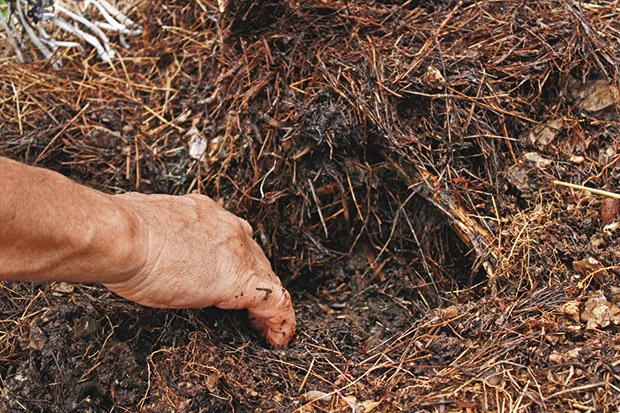
David regularly prunes trees and undergrowth for mulch, firewood, and fodder to provide their sheep and cow with a more diverse diet.
Over summer, it became clear their huge efforts over the last 10 months have paid off. There’s rampant growth from their garden and fruit trees, mostly healthy (bar some brown rot in the peaches), and no major pest issues. “So far, we’re quite positive about this style of farming and gardening. I look out there and it’s just lovely.
“We’re so grateful to be living here. I realise for a lot of people living like this isn’t necessarily achievable. But then, if you do own land, if you do downsize your debt, your life, and move to a smaller rural area like Taumarunui, it is achievable. To me it’s a no-brainer, but then I don’t know why people live in Auckland. “We’re so happy to be here, and that’s the biggest win.”
THE NO POWER BILL PLAN
When the Stewarts first moved in, their house was off-grid, but in the most basic way. “(The previous owners) were living off two little solar panels, a single battery, no fridge, a wood stove, and a little 2kw Honda generator, so we lived like that for five months.”
The first expert they consulted said the region didn’t get enough sunlight hours, so solar panels would never work. “That turned out to be wrong, so, so wrong,” says Rebecca.
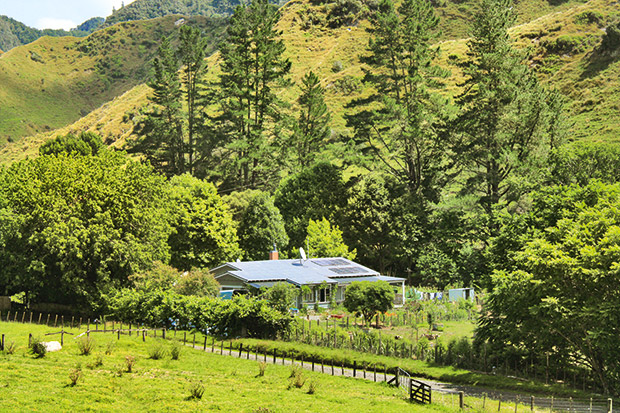
The expert the Stewarts first consulted told them they’d never produce enough power as they wouldn’t get enough sunny days. Rebecca says her biggest learning has been finding out that solar panels don’t need sun – they need light, so even if it’s a cloudy day, you can still generate power.
She kept looking for something they could install themselves as it’s expensive to get tradespeople to make the long trek. “Then we found GridFree. I liked them because they had the price, they had a list of stuff you could run on each kit in winter when you had lower power coming in, and I thought their kit would do what we wanted. We asked them some questions and their service was good.”
Depending on the inverter you choose, you can do the whole thing by yourself. Some systems require an electrician do certain parts of the work. Rebecca and David chose the ‘Freedom’ kit with a hybrid inverter they could self-install to power their conventionally wired home.
“Most of the components are pre-wired. We had to adapt ours slightly because it’s a 1920 bungalow and we’ve got 3m studs. But all we had to do was secure it, plug it together – they have a booklet, a wiring guide, and they’re great at answering questions – and it’s all ready to go.”
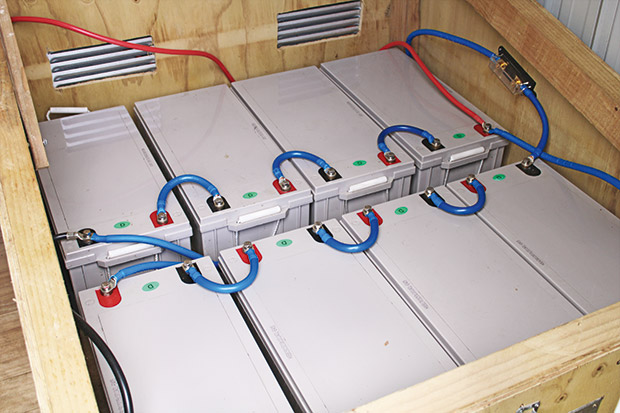
The results were illuminating. “We have lots of power, more power than I thought we would ever have. Even running everything we own, we barely hit 25% of our load capacity.”
That includes a conventional washing machine and chest freezer, a very big, low power Samsung inverter fridge, the internet, laptops, TV, and other gadgets. Depending on your system, there’s sometimes not enough energy to power high-draw appliances such as blenders and vacuums, so Rebecca was thrilled she didn’t have to give up anything.
“There’s no hardship, and we don’t have a power bill, so that’s a yay!” They use a wood stove and gas cooker in the kitchen, and the hot water cylinder is heated using a wetback. There’s no pump to power either, as they use a gravity-fed system to move water around the farm and into the house.
WHY THE STEWARTS MEASURE THE LIFE IN THEIR SOIL
Standard soil tests show you the total amount of nutrients present in the soil, but not whether they’re biologically available for plants to use. That’s why the Stewarts chose to do a Reams soil test that measures the biologically soluble levels of major nutrients.
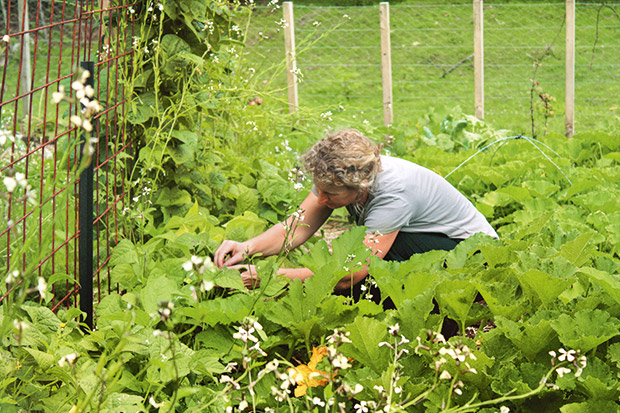
In just 10 months, the couple have noticed big changes in their soil, with increasing signs of bacterial and fungal life, and much higher numbers of earthworms.
“The results were worse than we expected,” says Rebecca. “The pine block was actually better than the home paddock.” They could see older, deep-rooted plants were healthy, but shallow-rooted plants such as pasture grasses were struggling.
Since they’ve started working on rebuilding their soil’s fertility, they’ve noticed significant changes. “There’s now plenty of worm activity in many of the areas we have dug, especially the vegetable garden.
“We’re not going to add tons of lime, which is often the recommended method. We’re going to slowly adjust the soil, observe, and support plant growth.”
MORE HERE
The Christchurch couple living self-sufficient dream in their half-acre urban garden
Love this story? Subscribe now!
 This article first appeared in NZ Lifestyle Block Magazine.
This article first appeared in NZ Lifestyle Block Magazine.
